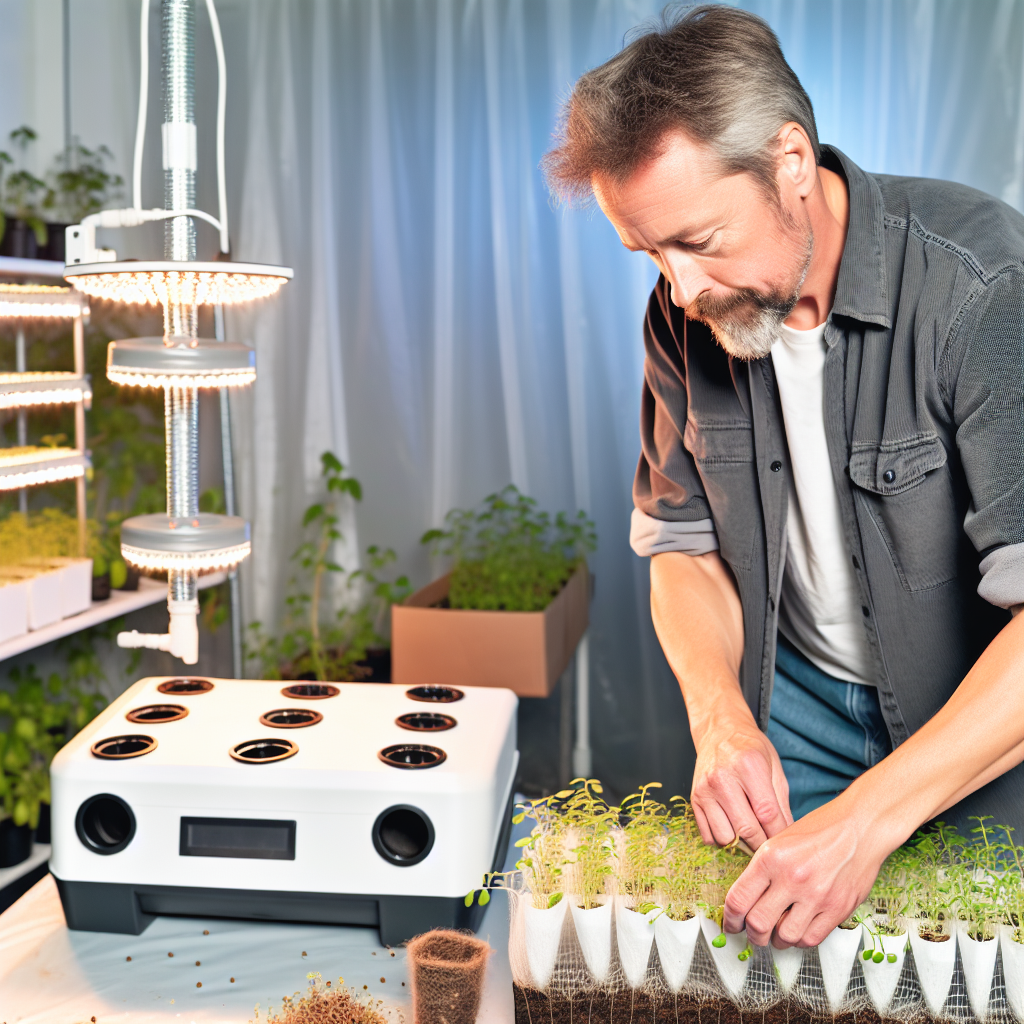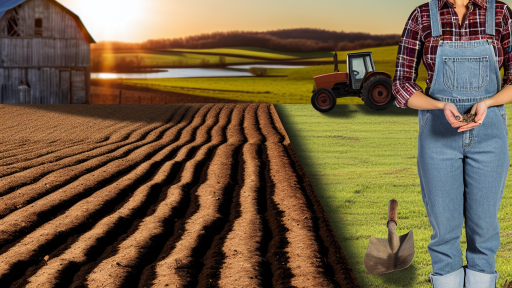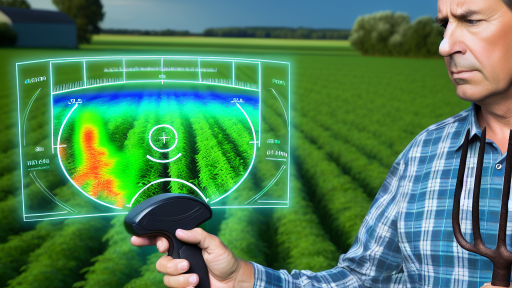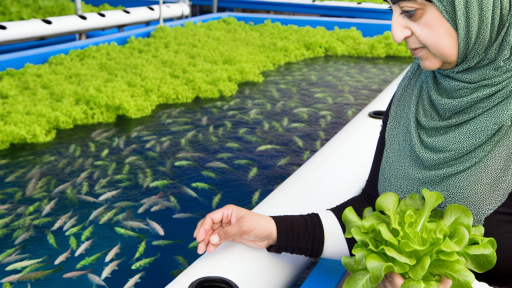Introduction to Hydroponics
What is Hydroponics?
Hydroponics is a method of growing plants without soil.
Instead, it uses nutrient-rich water to facilitate plant growth.
This technique allows for precise control over nutrients.
Additionally, it can occur indoors or outdoors, depending on the setup.
Benefits of Hydroponics
One main benefit is faster plant growth compared to traditional methods.
Plants receive optimal nutrient delivery through the water solution.
This method also saves space since it allows vertical gardening.
Moreover, hydroponics minimizes the use of pesticides and herbicides.
Consequently, this leads to cleaner and healthier produce.
Environmental Impact
Hydroponics uses significantly less water than conventional farming.
As a result, it contributes to water conservation efforts.
This method also reduces soil erosion and degradation.
Furthermore, it can be conducted in urban settings, reducing transportation emissions.
Economic Advantages
Starting a hydroponic garden can be cost-effective in the long run.
It provides access to fresh produce year-round, even in non-growing seasons.
Transform Your Agribusiness
Unlock your farm's potential with expert advice tailored to your needs. Get actionable steps that drive real results.
Get StartedThis approach can lead to significant reductions in food costs.
Additionally, it opens opportunities for local entrepreneurship.
Choosing the Right Location for Your Hydroponic Garden
Evaluating Space Requirements
Begin by assessing how much space you have available for your hydroponic garden.
Consider both indoor and outdoor options based on your preferences.
Measure the area to ensure it accommodates your chosen hydroponic system.
Additionally, think about the height of your space for vertical gardens.
Light Availability
Light is crucial for plant growth in hydroponics.
Choose a location that receives ample natural sunlight if possible.
Identify spots that get at least six hours of indirect sunlight daily.
If natural light is insufficient, consider installing grow lights.
Temperature and Humidity Control
Maintain an optimal temperature for your plants to thrive.
Avoid locations with extreme temperature fluctuations.
Indoor gardens typically require a stable climate.
Measure humidity levels and ensure they are suitable for your crops.
Water Supply and Drainage
Access to a reliable water supply is essential for any hydroponic garden.
Choose a location near water sources to facilitate easy irrigation.
Furthermore, ensure good drainage to prevent waterlogging.
Consider using containers or trays that allow excess water to escape.
Access to Electricity
Hydroponic systems often rely on electrical equipment.
Ensure your chosen location has easy access to electrical outlets.
Plan for lighting, pumps, and fans that may require power.
Additionally, you may need timers and controllers for automation.
Protection from Pests and Diseases
Location plays a significant role in pest management.
Choose a sheltered area to protect plants from harsh weather.
Showcase Your Farming Business
Publish your professional farming services profile on our blog for a one-time fee of $200 and reach a dedicated audience of farmers and agribusiness owners.
Publish Your ProfileMoreover, consider barriers like nets to keep pests away.
Regularly inspect plants for signs of disease or infestation.
Local Climate Considerations
Your local climate affects plant survival and growth.
Research the best hydroponic crops suited for your region.
Account for seasonal variations that may affect your setup.
Adapt your garden plans based on climate observations.
Essential Equipment and Supplies for Hydroponic Gardening
Growing Systems
A hydroponic garden begins with a reliable growing system.
Various systems exist, such as deep water culture and nutrient film technique.
Choose a system based on your plant preferences and space availability.
Each system has unique benefits and requirements.
Grow Lights
Proper lighting is crucial for plant growth in hydroponics.
LED grow lights are energy-efficient and effective.
Fluorescent lights also work well for seedlings and herbs.
Ensure your lighting setup covers the entire growing area adequately.
Nutrient Solutions
Hydroponic plants require specific nutrient solutions.
Purchase pre-made mixtures or create your own using base nutrients.
Monitor pH levels regularly to ensure optimal plant health.
Adjust nutrient concentration based on growth stages and plant types.
Growing Mediums
A suitable growing medium supports plant roots in hydroponics.
Coconut coir, perlite, and Rockwool are popular options.
Choose a medium that drains well while retaining moisture.
Different mediums affect water retention and nutrient delivery.
Water Filtration System
Clean water is vital for any hydroponic setup.
Utilize a filtration system to remove contaminants and chlorine.
Consider using reverse osmosis systems for high-quality water.
Regularly check water quality to maintain a healthy environment.
Containers and Reservoirs
Choose containers based on the size and type of your plants.
Reservoirs hold nutrient solutions and water for the system.
Ensure they are made from materials that won’t leach harmful substances.
Position containers to maximize light exposure and access.
Delve into the Subject: Utilizing Technology In Pest And Disease Forecasting
Selecting the Best Hydroponic System
Exploring Different Hydroponic Systems
Choosing the right hydroponic system is crucial for your garden’s success.
There are several systems available, each with unique advantages.
Common systems include Nutrient Film Technique and Deep Water Culture.
Let’s explore each option in more detail.
Nutrient Film Technique
Nutrient Film Technique, or NFT, is a popular hydroponic method.
This system uses a thin film of nutrient solution running over the roots.
It requires a continuous flow of water for optimal growth.
Benefits of NFT include efficient nutrient use and rapid plant growth.
However, it can be sensitive to pump failures.
Showcase Your Farming Business
Publish your professional farming services profile on our blog for a one-time fee of $200 and reach a dedicated audience of farmers and agribusiness owners.
Publish Your ProfileDeep Water Culture
Deep Water Culture, or DWC, allows plants to float on a nutrient-rich solution.
This system ensures roots remain submerged in oxygenated water.
DWC is straightforward and beginner-friendly.
It supports strong plant growth through abundant oxygen supply.
Nevertheless, it requires careful monitoring of oxygen levels.
Wick System
The wick system uses a passive method to deliver nutrients.
Wicks draw nutrient solution from a reservoir to the plants.
This system is simple and doesn’t require pumps.
However, it may not provide enough nutrients for high-demand crops.
Understanding Your Space and Budget
Your available space will significantly impact your choice of system.
Consider the size and layout of your gardening area.
Also, evaluate your budget before finalizing a system.
Some systems require more complex setups than others.
Choose a system that fits your financial and spatial constraints.
Evaluating Plant Types and Goals
Different hydroponic systems suit various types of plants.
Specify what you want to grow before selecting a system.
Leafy greens may thrive in NFT or DWC systems.
Fruit-bearing plants might require a more robust system.
Identify your gardening goals to guide your decision.
Discover More: Enhancing Soil Fertility with Cover Crops
Understanding Plant Nutrition and Hydroponic Nutrient Solutions
The Basics of Plant Nutrition
Plants require essential nutrients for growth and development.
These nutrients are divided into macronutrients and micronutrients.
Macronutrients include nitrogen, phosphorus, and potassium.
Micronutrients consist of elements like iron, manganese, and zinc.
Each nutrient plays a specific role in plant health.
Nitrogen promotes leaf growth and green foliage.
Phosphorus supports root development and flowering.
Potassium enhances overall plant health and disease resistance.
Micronutrients are equally important, albeit needed in smaller amounts.
Hydroponic Nutrient Solutions
Hydroponic systems require nutrient solutions to feed plants directly.
These solutions typically contain water and mineral nutrients.
Commercial nutrient solutions are readily available for hydroponic gardeners.
Some gardeners prefer to create their own blends for specific plant needs.
Monitoring pH levels is crucial for nutrient absorption.
The ideal pH range for most hydroponic plants is between 5.5 and 6.5.
Choosing Nutrient Solutions
Selecting the right nutrient solution depends on the plants you intend to grow.
Different plants have varying nutrient requirements.
Researching specific needs helps optimize plant growth.
Common nutrient brands like General Hydroponics and Advanced Nutrients offer tailored options.
Reading product labels ensures that you choose the best formulation.
Showcase Your Farming Business
Publish your professional farming services profile on our blog for a one-time fee of $200 and reach a dedicated audience of farmers and agribusiness owners.
Publish Your ProfilePreparing and Mixing Nutrient Solutions
Always follow the manufacturer’s mixing guidelines.
Start by measuring the right amount of water.
Next, add concentrated nutrient solutions gradually.
Stir the mixture thoroughly to ensure even distribution.
After mixing, check the pH and adjust if necessary.
Maintaining Nutrient Levels
Nutrient levels deplete over time and require monitoring.
Regularly test the solution using a TDS meter.
Make adjustments according to your plants’ growth stages.
It’s important to change the nutrient solution regularly.
Most systems benefit from a solution change every two weeks.
Using Organic Nutrients
Some growers opt for organic nutrient solutions.
Organic options provide a sustainable approach to hydroponics.
Popular choices include bat guano and fish emulsion.
These organic nutrients can still provide essential macros and micros.
However, they may require more careful monitoring.
Learn More: Organic Fertilizers: Boosting Crop Growth Naturally
Common Hydroponic Crops: What to Grow and When
Leafy Greens
Leafy greens are among the easiest crops to grow hydroponically.
Lettuce, spinach, and kale thrive in these systems.
You can grow them all year round with the right setup.
For the best results, prioritize greens like lettuce in cooler months.
Herbs
Herbs add flavor while thriving in hydroponic systems.
Basil, mint, and cilantro are popular choices.
Plant herbs in early spring for optimal growth.
Harvest them regularly to encourage new growth.
Fruiting Plants
Fruiting plants like tomatoes and peppers thrive in hydroponics.
Choose varieties that adapt well to indoor conditions.
Start these plants in late winter or early spring.
Provide adequate light and nutrients for healthy fruits.
Succession Planting
Consider succession planting to maximize your garden’s yield.
This technique involves planting crops at intervals.
By doing this, you ensure a continuous harvest.
Rotate crops based on the seasons for optimal growth.
Climate Considerations
Your local climate influences what and when you can grow.
Research your region’s growing seasons carefully.
Use indoor systems to extend the growing season if necessary.
This approach allows for year-round gardening in any climate.
See Related Content: Comprehensive Guide to Mulching in Crop Cultivation

Setting Up Your Hydroponic Garden
Selecting the Right Location
Choose a location that receives plenty of natural light.
Make sure the area has good air circulation.
Additionally, avoid places with extreme temperature fluctuations.
Showcase Your Farming Business
Publish your professional farming services profile on our blog for a one-time fee of $200 and reach a dedicated audience of farmers and agribusiness owners.
Publish Your ProfileGathering Necessary Supplies
Start with a hydroponic system, such as deep water culture or nutrient film technique.
Collect the necessary equipment, including pumps, lights, and timers.
Don’t forget to acquire nutrient solutions specific for hydroponics.
Preparing the Growing Medium
Use materials like rock wool, coconut coir, or perlite as your growing medium.
Ensure the medium provides good drainage and aeration.
Next, pre-soak the medium to enhance moisture retention.
Setting Up the Hydroponic System
Install the system according to the manufacturer’s instructions.
Make sure all components are securely connected.
Carefully test the water pH and nutrient levels before planting.
Choosing the Right Plants
Select fast-growing plants like lettuce or herbs for beginners.
Consider your personal preference and local climate conditions.
Remember, some plants thrive better in hydroponic systems than others.
Monitoring and Maintenance
Regularly check nutrient levels and pH balance in your system.
Observe plant health and growth for any signs of deficiency.
Additionally, clean the system to prevent algae and bacteria growth.
Harvesting Your Produce
Harvest plants at their peak flavor and freshness.
Use clean tools to avoid damaging the plants during harvest.
Finally, enjoy the fruits of your labor in delicious meals.
Maintaining Your Hydroponic Garden
Importance of Monitoring pH Levels
pH levels are crucial for the health of your plants.
They affect nutrient absorption significantly.
Check pH regularly using a reliable tester.
Aim for a pH between 5.5 and 6.5 for optimum growth.
Adjust pH with appropriate solutions as needed.
Managing Nutrient Concentration
Nutrients are essential for plant development in hydroponics.
Monitor nutrient levels using an electrical conductivity meter.
This tool indicates how concentrated your nutrient solution is.
Maintain a suitable concentration based on the plants you grow.
Over- or under-fertilizing can stunt growth or cause damage.
Light Requirements in Hydroponics
Light plays a vital role in photosynthesis.
Different plants have unique light requirements.
Understand the needs of your specific plants.
Use timers to ensure consistent light exposure.
Position grow lights at the correct distance from plants.
Routine Checks and Adjustments
Regularly inspect your hydroponic system for any issues.
Look for signs of nutrient deficiencies or excesses.
Adjust your system according to environmental changes.
Keep a log of all measurements and adjustments.
This practice helps track your garden’s progress over time.
Troubleshooting Common Issues in Hydroponic Gardening
Identifying Plant Stress
Plants can show signs of stress for several reasons.
First, check for yellowing leaves.
Showcase Your Farming Business
Publish your professional farming services profile on our blog for a one-time fee of $200 and reach a dedicated audience of farmers and agribusiness owners.
Publish Your ProfileThis often indicates nutrient deficiency.
Next, observe for wilting plants.
Wilting can suggest overwatering or underfeeding.
Finally, inspect the roots for rot.
Root rot occurs from poor drainage or over-saturation.
Checking Nutrient Levels
Nutrient levels are crucial in hydroponic gardening.
Use a reliable pH and EC meter regularly.
Adjust nutrient solutions based on your findings.
Moreover, consider the types of plants you are growing.
Each plant may have different nutrient requirements.
Managing Light Conditions
Improper lighting can hamper growth significantly.
Ensure your plants receive 12 to 16 hours of light daily.
Use grow lights if natural light is insufficient.
Also, position the lights at an appropriate distance.
Too far can lead to insufficient growth, while too close can cause burning.
Controlling Temperature and Humidity
Temperature and humidity directly affect plant health.
Keep air temperatures between 65°F and 80°F.
High humidity can encourage mold growth.
Maintain humidity levels around 40% to 60% for optimal growth.
Use fans and dehumidifiers as needed.
Preventing Pests and Diseases
Pests can quickly invade a hydroponic system.
Inspect plants regularly for any unwanted visitors.
Utilize natural predators for pest control where possible.
Furthermore, keep your growing area clean and free of debris.
To prevent diseases, practice proper sanitation steps.
Implementing System Maintenance
Regular maintenance ensures a successful hydroponic garden.
Flush your system every few weeks to avoid buildup.
Additionally, clean all equipment thoroughly before the new cycle.
Check for leaks and repair any damaged parts immediately.
Maintaining an efficient system is key to productivity.
Harvesting and Enjoying the Fruits of Your Hydroponic Labor
Identifying the Right Time to Harvest
Timing is crucial when harvesting your hydroponic plants.
Observe the color and size of your fruits or vegetables.
Each type of plant has specific signs of ripeness.
Knowing these signs ensures peak flavor and nutrition.
Harvesting Techniques
Use sterilized scissors or pruners for a clean cut.
Make sure to cut stems and not just pull fruits off.
This prevents damage to the plant and promotes regrowth.
Be gentle to avoid bruising the produce.
Post-Harvest Care
After harvesting, take immediate care of the produce.
Rinse your fruits or vegetables under cold water.
Showcase Your Farming Business
Publish your professional farming services profile on our blog for a one-time fee of $200 and reach a dedicated audience of farmers and agribusiness owners.
Publish Your ProfileAllow them to dry naturally to maintain freshness.
Store your harvest in a cool, dry place.
Enjoying Your Hydroponic Produce
Discover new recipes that highlight your fresh ingredients.
Use fresh herbs to elevate any dish.
Experiment with salads, smoothies, or stir-fries.
The possibilities are endless with hydroponic produce.
Sharing Your Harvest
Consider sharing your bounty with friends and family.
Giving produce away can spread joy and knowledge.
Host a small gathering where guests can taste your creations.
Sharing your success makes growing worth it.
Reflecting on Your Hydroponic Journey
Take time to appreciate your efforts and growth.
Every harvest reflects dedication and care.
Learn from each growing cycle to improve future endeavors.
Your journey in hydroponics can be endlessly rewarding.
Additional Resources
DIY Hydroponics on the cheap. You don’t need to spend thousands …
Automated agriculture: Building a DIY hydroponic gardening system …




